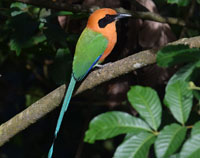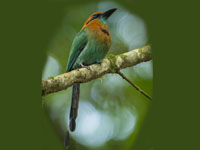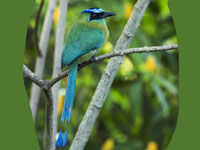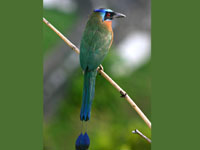Motmots are restricted to woodland or forest in the Neotropics, and the largest diversity is in Middle America. They have a colorful plumage and a relatively heavy bill. All except the tody motmot have long tails that in some species has a distinctive racket-like tip. These paddle-like ends of the tail are formed by barbs of the two central fall feathers that are weakly attached and fall off due to abrasion with substrates and during routine preening. This creates a distinctive racket shape to the tail. Motmots often move these long tails back and forth in a wag-display that signals to a predator that it has been detected. This signal provides a benefit to both the motmot and the predator: the display prevents the motmot from wasting time and energy fleeing, and the predator avoids a costly pursuit that is unlikely to result in capture.
Motmots eat small prey such as insects, spiders, centipedes, earthworms, and lizards. Most motmots will also eat fruit. They usually pluck prey from vegetation while flying but may also capture flying insects such as butterflies and dragonflies on the wing. They will also catch prey that is on the ground.
Like most of the Coraciiformes, motmots are cavity nesters. In this case the motmots create tunnels in earth banks, Both parents share in the excavation process of the approximately 1 to 2 meter long tunnel. Their feet are used to loosen the soil and to kick it along the tunnel to the entrance where an excavation mound accumulates.The tunnels are often curved, some even have right angle turns, to try to discourage predators such as snakes and lizards. Similarly, some species try to camouflage the entrance, The tunnel widens at the end where the eggs are deposited, incubated, and the chicks stay until fledging. There are about four white eggs which hatch after about 20 days, and the young leave the nest after another 30 days.
The motmot family Momotidae belongs to the Coraciiformes order, as do the bee-eaters of family Meropidae, the kingfishers of family Alcedinidae, the rollers of families Brachypteraciidae and Coraciidae, and the todies of family Todidae.
Genus Aspatha - 1 species
Motmot,_Blue-throated Aspatha gularis
Description: The blue-throated motmot has mainly green plumage with the underparts paler green. It has a blue throat, with a black spot just below it. There is a black ear-covert, and a small breast patch. The graduated tail of the blue-throated motmot does not have "paddles". It is 25.5 to 28 cm long and weighs 56 to 67 grams.
Range: El Salvador, Guatemala, Honduras, Mexico.
Habitat: Montane forests.
Diet: Insects, especially beetles. Takes prey from foliage while flying, It also easts some fruit.
Conservation status: Least Concern.
Image by: 1) Nick Athanas - Mexico 2) Adrian_Tween - Guatemala 3) Jorge_Montejo - MexicoRange: El Salvador, Guatemala, Honduras, Mexico.
Habitat: Montane forests.
Diet: Insects, especially beetles. Takes prey from foliage while flying, It also easts some fruit.
Conservation status: Least Concern.



Genus Baryphthengus
Both species have a long tail, a black mask, and a plumage that is mainly green and rufous.
Motmot,_Rufous Baryphthengus martii
Description: The rufous motmot has a cinnamon-rufous head, a black face mask, small black chest spot, green wings and flanks, greenish-blue lower body, and a dark blue tail with a "paddle". It is the second largest motmot of the family. The length is 42 to 47 cm and it weighs 145 to 210 grams.
Range: Northeastern Honduras south to western Ecuador, northeastern Bolivia, and southwestern Brazil.
Habitat: Forests that are not dense. Prefers tall trees near moving water.
Diet: Insects including beetles and grasshopper, arachnids, centipedes, scorpions.
Conservation status: Least Concern.
Image by: 1) Dominic
Sherony 2, 3) Nick Athanas - Panama, Ecuador 4) Andy_Reago-Chrissy_McClarren - Costa RicaRange: Northeastern Honduras south to western Ecuador, northeastern Bolivia, and southwestern Brazil.
Habitat: Forests that are not dense. Prefers tall trees near moving water.
Diet: Insects including beetles and grasshopper, arachnids, centipedes, scorpions.
Conservation status: Least Concern.




Motmot,_Rufous-capped Baryphthengus ruficapillus
Description: The rufous-capped motmot has mainly green upperparts and olive-green underparts. It has a rufous cap and a rufous lower breast band. There is black face mask and a small black upper-breast spot(s). The graduated tale does not have "paddles". It is about 42 cm long and weighs 140 to 150 grams which makes it one of the larger motmots.
Range: Argentina, Brazil, Paraguay.
Habitat: Lowland forests.
Diet: Mainly large insects and larvae. Also snails, small mammals and reptiles, some fruit.
Conservation status: Least Concern.
Image by: 1) Claudio_Timm - Brazil 2) Carlos_Henrique - Brazil 3) Luiz_Carlos_Rocha - Brazil 4)Hector_Bottai - BrazilRange: Argentina, Brazil, Paraguay.
Habitat: Lowland forests.
Diet: Mainly large insects and larvae. Also snails, small mammals and reptiles, some fruit.
Conservation status: Least Concern.




Genus Electron
These two species have wider bills than other genera. The "rackets" on their tales may be absent.
Motmot,_Broad-billed Electron platyrhynchum
Description: The broad-billed motmot has mainly cinnamon-rufous upperparts, head, neck, and breast. There are black spots on the breast and there is a black line under the eye. The chin and belly are blue-green. It has a broad base of the bill. The long tail gradually turns from blue to black and may terminated in two racket-like shapes. This is one of the smallest members of the family with a length between 31 to 39 cm and a weight between 56 and 66 grams.
Range: Eastern Central America from Honduras to Panama, and northwestern South America.
Habitat: Humid forests below 1800 m.
Diet: Mainly insects and larvae. Also spiders, centipedes, reptiles.
Conservation status: Least Concern.
Image by: 1) Francesco_Veronesi - Costa Rica 2) Fotografia_Azul_Profundo 3) Nick Athanas - Ecuador 4) Alex_Proimos - Costa RicaRange: Eastern Central America from Honduras to Panama, and northwestern South America.
Habitat: Humid forests below 1800 m.
Diet: Mainly insects and larvae. Also spiders, centipedes, reptiles.
Conservation status: Least Concern.




Motmot,_Keel-billed Electron carinatum Found: Central America
Description: The keel-billed motmot has mainly green upperparts, olive-cinnamon underparts, a reddish forehead, black mask, broad bill, blue supercilium, and a black breast spot. It can be differentiated from the similar broad-billed motmot by its blue supercilium
Range: Belize, Costa Rica, Guatemala, Honduras, Nicaragua, and Mexico.
Habitat: Humid evergreen forests.
Diet: Mainly insects and larvae. Also spiders, centipedes, reptiles.
Conservation status: The keel-billed motmot is listed as Vulnerable because their sites are scattered and experiencing deforestation.
Image by: 1) Dominic
Sherony 2) Francesco_Veronesi - Costa Rica 3) Jorge_Arroyo - Costa Rica 4) Alan_Harper - Honduras Range: Belize, Costa Rica, Guatemala, Honduras, Nicaragua, and Mexico.
Habitat: Humid evergreen forests.
Diet: Mainly insects and larvae. Also spiders, centipedes, reptiles.
Conservation status: The keel-billed motmot is listed as Vulnerable because their sites are scattered and experiencing deforestation.




Genus Eumomota - 1 species
Motmot,_Turquoise-browed Eumomota superciliosa
Description: The turquoise-browed motmot has a pale and wide turquoise supercilium with a black mask. There is also a black throat patch bordered by white. It has mainly olive-green upperparts and a rufous belly. Its most eye-catching feature is its mainly blue tail and its long tail rackets. It is 34 cm long and weighs 65 grams.
Range: Central America - southeast Mexico to Costa Rica.
Habitat: Fairly open forest, forest edges, scrubland.
Diet: Insects, spider, centipedes, small reptiles, earthworms, some fruit.
Conservation status: Least Concern.
Image by: 1) Jerry
Oldenettel - Costa Rica 3) Alastair
Rae 3) Katja Schulz - Mexico 4) Michael_Klotz - NicaraguaRange: Central America - southeast Mexico to Costa Rica.
Habitat: Fairly open forest, forest edges, scrubland.
Diet: Insects, spider, centipedes, small reptiles, earthworms, some fruit.
Conservation status: Least Concern.




Genus Hylomanes - 1 species
Motmot,_Tody Hylomanes momotula
Description: The tody motmot has a green back, crown, and rump. It has a greenish breast with light streaks and a white belly. There is a light stripe below the eye and a black half eye-stripe. The neck is rufous. It is the smallest motmot with length of 16.5 to 18 cm and a weight of 27 to 33 grams.
Range: Mexico, Central America, Columbia.
Habitat: Humid evergreen forest. It particularly like ravines.
Diet: Insects, spiders, and snails. Unlike most motmots, it does not like fruit. It plucks prey from vegetation while flying and also captures butterflies and dragonflies on the wing.
Conservation status: Least Concern.
Image by: 1) Mdf - Panama 2) Nick Athanas - Costa Rica 3) Dominic_SheronyRange: Mexico, Central America, Columbia.
Habitat: Humid evergreen forest. It particularly like ravines.
Diet: Insects, spiders, and snails. Unlike most motmots, it does not like fruit. It plucks prey from vegetation while flying and also captures butterflies and dragonflies on the wing.
Conservation status: Least Concern.



Genus Momotus
All but one of these species used to be considered subspecies of the blue-crowned motmot. These six closely related species are: Amazonian motmot, Andean motmot, blue-capped motmot, Lesson's motmot, Trinidad motmot, and whooping motmot. They mostly have in common a black crown center surrounded by a blue band, a mask, and a long tail with rackets, The blue-capped motmot has a completely blue crown.
Motmot,_Amazonian Momotus momota
Description: The Amazonian motmot has a black cap surrounded by a blue crown, black eye-mask, and a chestnut nape. It has a long tail with a racket tip. It was formerly a subspecies of the blue-crowned motmot.
Range: Eastern Venezuela to northeastern Argentina and eastern Brazil. Located in Amazonian lowlands and eastern Andean foothills.
Habitat: Humid lowland forests and their edges.
Diet: Insects, spider, centipedes, small reptiles, earthworms; some fruit.
Conservation status: Least Concern.
Image by: 1) Dave_Curtis - Brazil 2) Luciano_Bernardes - BrazilRange: Eastern Venezuela to northeastern Argentina and eastern Brazil. Located in Amazonian lowlands and eastern Andean foothills.
Habitat: Humid lowland forests and their edges.
Diet: Insects, spider, centipedes, small reptiles, earthworms; some fruit.
Conservation status: Least Concern.


Motmot,_Andean Momotus aequatorialis
Description: The Andean motmot, .also known as highland motmot, has a black central crown surrounded by a blue band. The blue band is light at the front and darker across the rear. The Andean motmot has a black breast spot. The rest of the plumage is mainly green. It is 46 to 48 cm in length and weighs 140 to 200 grams. It was formerly a subspecies of the blue-crowned motmot. It is differentiated by the similar Andean motmot by having more green on its underparts.
Range: Andean Mountains from Columbia to Bolivia.
Habitat: Humid montane forests. Replaced at lower altitudes by the Amazonian motmot.
Diet: Insects, spider, centipedes, small reptiles, earthworms; some fruit.
Conservation status: Least Concern.
Image by: 1) Alejandro Tamayo 2) Dave Curtis - Columbia 3) Nick Athanas - Columbia 4) Alejandro_Bayer_Tamayo - ColumbiaRange: Andean Mountains from Columbia to Bolivia.
Habitat: Humid montane forests. Replaced at lower altitudes by the Amazonian motmot.
Diet: Insects, spider, centipedes, small reptiles, earthworms; some fruit.
Conservation status: Least Concern.




Motmot,_Blue-capped Momotus coeruliceps Found: eastern Mexico
Description: The blue-capped motmot has a dark blue central crown surrounded by blue ring and a black eye-mask. It was formerly a subspecies of the blue-crowned motmot. It is the only one of this complex that has an entirely blue cap - there is no black central section. It is 38 to 43 cm in length.
Range: Northeast Mexico - (Nuevo León and Tamaulipas to n Veracruz). Its range abuts on the south the Lesson's motmot.
Habitat: Lowland forest, shady gardens, coffee plantations.
Diet: Insects, their larvae, beetles, cicadas, lizards, berries.
Conservation status: Least Concern.
Image by: 1) Juan_Miguel_Artigas_Azas 2) Roberto_GonzálezRange: Northeast Mexico - (Nuevo León and Tamaulipas to n Veracruz). Its range abuts on the south the Lesson's motmot.
Habitat: Lowland forest, shady gardens, coffee plantations.
Diet: Insects, their larvae, beetles, cicadas, lizards, berries.
Conservation status: Least Concern.


Motmot,_Lesson's Momotus lessonii Found: Mexico, Central America
Description: The Lesson's motmot has a black cap surrounded by a blue crown and black eye-mask. It was formerly a subspecies of the blue-crowned motmot. The only similar motmots in its range are the blue-capped motmot to the north and the whooping motmot to the south. The blue-capped motmot is easy to distinguish because of its blue cap. The whooping motmot has tawny versus the more green underparts of Lesson's motmot.
Range: Southern Mexico to northern Panama. To the north of the Lesson's motmot range is the blue-capped motmot and to the south is the whooping motmot.
Habitat: Various types of wooded habitats.
Diet: Insects, snails, centipedes, earthworms, small reptiles and mammals, fruit.
Conservation status: Least Concern.
Image by: 1) Nick Athanas - Costa Rica 2) Michelle_Reback - Costa Rica 3) Dominic_Sherony- BelizeRange: Southern Mexico to northern Panama. To the north of the Lesson's motmot range is the blue-capped motmot and to the south is the whooping motmot.
Habitat: Various types of wooded habitats.
Diet: Insects, snails, centipedes, earthworms, small reptiles and mammals, fruit.
Conservation status: Least Concern.



Motmot,_Russet-crowned Momotus mexicanus
Description: The russet-crowned motmot has reddish-brown crown and nape. It has bluish-green upperparts, green underparts, orange-brown cap, and black eye-arc with blue below. It has a long tail with rackets. The length is 30 to 36 cm and weight is 75 to 100 grams.
Range: Guatemala, western Mexico.
Habitat: Tropical and subtropical dry broadleaf forests and scrubland.
Diet: Mainly large insects taken from foliage, ground, or on the wing..
Conservation status: Least Concern.
Image by: 1) Francesco_Veronesi - Mexico 2) Amy_McAndrews - Mexico 3) Nick Athanas - Mexico 4) Len Blumin - Mexico Range: Guatemala, western Mexico.
Habitat: Tropical and subtropical dry broadleaf forests and scrubland.
Diet: Mainly large insects taken from foliage, ground, or on the wing..
Conservation status: Least Concern.




Motmot,_Trinidad Momotus bahamensis
Description: The Trinidad motmot has a black cap surrounded by a blue crown and a black eye-mask. It was formerly a subspecies of the blue-crowned motmot. There are no similar motmots on the islands where it is found.
Range: Trinidad, Tobago.
Habitat: Forests and woodlands. It is more common on Tobago than on Trinidad.
Diet: Insects, lizards, snails, fruit.
Conservation status: Least Concern.
Image by: 1) Stephan_Turner - Tobago 2) Cheesy42 - Tobago 3) Allan_HopkinsRange: Trinidad, Tobago.
Habitat: Forests and woodlands. It is more common on Tobago than on Trinidad.
Diet: Insects, lizards, snails, fruit.
Conservation status: Least Concern.



Motmot,_Whooping Momotus subrufescens
Description: The whooping motmot hasa black central crown surrounded by a blue band. It has a black eye mask and there is a small turquoise patch below the mask. It has olive-green upperparts and dull brown underparts It was formerly a subspecies of the blue-crowned motmot. The whooping motmot's name refers to its hooting call.
Range: Southern Panama, northwestern South America.
Habitat: Forests and forest edges.
Diet: Not much known. Probably similar to other members of its genus.
Conservation status: Least Concern.
Image by: 1) Nick Athanas - Panama, Columbia, Ecuador 4) Sergey_Pisarevskiy - ColumbiaRange: Southern Panama, northwestern South America.
Habitat: Forests and forest edges.
Diet: Not much known. Probably similar to other members of its genus.
Conservation status: Least Concern.




There are five species in the tody family, Todidae, and they all belong to the Todus genus.They are very small ( 10 to 11.5 cm long and 5 to 7 grams), chunky, short-tailed birds, with green upperparts, a red throat, yellow under-tail coverts, and a long, flattened bill. They are found in the Caribbean.
Todies mainly eat grasshoppers, crickets, beetles, bugs, butterflies, bees, wasps, and ants. They also eat spiders, millipedes, and fruit. They perch on a low, small branch from which they scan the upper-sides and, occasionally, uppersides of leaves for insects. When spotted they will swoop down or up, respectively to catch the insect. The smaller insects are swallowed in air while the larger ones are smashed against twigs before consumption. They occasionally take prey on the ground via a downward flight or may hop after it. In order of preference the prey locations they prefer are: leaves, trunks, branches and twigs, air; and the ground,
bee-Eatersof family Meropidae, the kingfishers of family Alcedinidae, the motmots of family Momotidae, and the rollers of families Brachypteraciidae and Coraciidae.
Genus Todus
Tody,_Broad-billed Todus subulatus
Description: The broad-billed tody has green upperparts, a red throat, pinkish flanks, and yellowish lower-belly. The upper-mandible is black and the lower mandible is red. The bill is the widest of the tody family. The similar narrow-billed tody is also endemic to Hispaniola. The narrow-billed tody has whiter underparts and tends to occur at higher altitudes. Where their ranges overlap, the broad-billed tody usually forages higher above the ground than does the narrow-billed tody, thus they do not deplete each others food supply. While the broad-billed and narrow-billed todies are similar, they diverged more than 2 million years ago.
Range: Hispaniola.
Habitat: Prefer drier habitats to that of wet rainforests. Found at less than 1700 meters.
Diet: Insects.
Conservation status: Least Concern.
Image: 1) Carlos_De_Soto_Molinari 2) ZankaM - Dominican Republic ) Ron KnightRange: Hispaniola.
Habitat: Prefer drier habitats to that of wet rainforests. Found at less than 1700 meters.
Diet: Insects.
Conservation status: Least Concern.



Tody,_Cuban Todus multicolor
Description: The Cuban tody has bright green upperparts, a red throat, yellow lores, and a blue ear patch, The bill is black on the top and red on the bottom. It has whitish-gray underparts and pink flanks.
Range: Cuba and nearby islands. There are no other todies in its range.
Habitat: It is known to live in dry lowlands, evergreen forests, coastal vegetation, and near streams and rivers.
Diet: Mainly insects; also spiders, lizards, fruit.
Conservation status: Least Concern.
Image by: 1, 2) Charles_Sharpe 3) Francesco_VeronesiRange: Cuba and nearby islands. There are no other todies in its range.
Habitat: It is known to live in dry lowlands, evergreen forests, coastal vegetation, and near streams and rivers.
Diet: Mainly insects; also spiders, lizards, fruit.
Conservation status: Least Concern.



Tody,_Jamaican Todus todus
Description: The Jamaican tody has green upperparts, a red throat, white upper-breast, and the rest of the underparts are yellowish. It has a long, flat and broad red bill. The legs are reddish-brown. It averages 9 cm in length and 6.4 grams in weight.
Range: Jamaica.
Habitat: All parts of the island of Jamacia, but most common in forests.
Diet: Mainly insects and their larvae; also fruit. The Jamaican tody helps keep the pests on coffee farms under control, leading to more saleable fruit, increased coffee yields and increased income for farmers.
Conservation status: Least Concern.
Image by: 1) Dominic_Sherony 2) Charles_J_Sharp 3) Ron_KnightRange: Jamaica.
Habitat: All parts of the island of Jamacia, but most common in forests.
Diet: Mainly insects and their larvae; also fruit. The Jamaican tody helps keep the pests on coffee farms under control, leading to more saleable fruit, increased coffee yields and increased income for farmers.
Conservation status: Least Concern.



Tody,_Narrow-billed Todus angustirostris
Description: The narrow-billed tody has green upperparts, a red throat, and mainly white underparts. The upper mandible is black; the lower mandible has a red base and is tipped in black. It has red flanks, a yellow lower-belly and yellow under-tail coverts. The similar broad-billed tody is also endemic to Hispaniola. The narrow-billed tody has whiter underparts and tends to occur at higher altitudes. Where their ranges overlap, the broad-billed tody usually forages higher above the ground than does the narrow-billed tody, thus they do not deplete each others food supply. While the broad-billed and narrow-billed todies are similar, they diverged more than 2 million years ago.
Range: The island of Hispaniola (Dominican Republic, Haiti)
Habitat: Subtropical or tropical moist montane forests. They can tolerate heavily degraded forests.
Diet: Mianly insects.
Conservation status: Least Concern.
Image by: 1) Ron Knight 2) Gil_EwingRange: The island of Hispaniola (Dominican Republic, Haiti)
Habitat: Subtropical or tropical moist montane forests. They can tolerate heavily degraded forests.
Diet: Mianly insects.
Conservation status: Least Concern.


Tody, Puerto Rican Todus mexicanus
Description: The Puerto Rican tody has green upperparts, white underparts, light yellow flanks, a red throat, and a red lower mandible. It has an average length of 11 cm and a weight of 5 to 6 grams. The male has gray eyes and the female has white eyes. The Puerto Rican tody differs from the other Greater Antilles todies in that it is the only species without pink or yellow-green colored feathers on its flanks. Its closest relative is probably the Jamaican tody.
Range: Puerto Rico.
Habitat: Throughout the island of Puerto Rico, but mainly in forested areas.
Diet: Insects.
Conservation status: Least Concern.
Image by: 1, 2, 3) Dick Daniels - Puerto Rico Range: Puerto Rico.
Habitat: Throughout the island of Puerto Rico, but mainly in forested areas.
Diet: Insects.
Conservation status: Least Concern.




